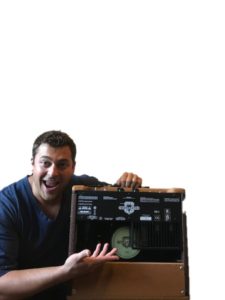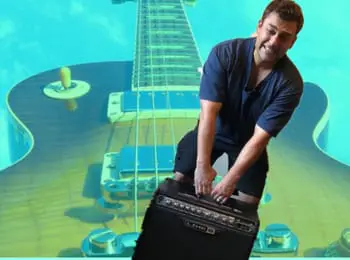
It feels like yesterday that I was unloading my amp in a dark smokey bar late at night.
Getting ready to do a quick set change, the faster the band before you get off, the quicker you can get on and get your set started.
But, I’ll be damned if it wasn’t for that amplifiers weight. It always amazed me at how massive guitar amplifiers were.
Guitar amps are heavy due to speaker magnets, power and output transformers, and metal chassis and wooden cabinets.
Yep, those few items literally wreak havoc on your back before you can even get plugged in and tuned up.
I want to take a look at quickly understanding these cumbersome components and then give a few tips on how to save your back.
I’m extremely spine conscious since I’ve had to have 3 spinal surgeries in the past.
( I don’t think this was ever directly related or caused by my heavy amp, but who really knows).
Contents
- 1 Those Heavy Magnets!
- 2 Power and Output Transformers
- 3 Metal Chassis and Wooden Cabinets
- 4 What can you do to save your back?
- 5 Tip 1: Use Rollers or Dollies
- 6 Tip 2: Get a second pair of hands!
- 7 Tip 3: Bend with your legs
- 8 Tip 4: Strengthen your lower back and abdominal
- 9 Tip 5: Wear a Belt
- 10 In Summary:
Those Heavy Magnets!
This is probably the first reason why guitar amps are so heavy.
Those heavy magnets while being heavy actually serve a huge purpose.
For an electrical signal to be turned into audible sound, you will need to have magnets in your amplifier.
Speakers contain an electromagnet which creates a magnetic field when current flows through it. In return, this is what creates vibration back and forth allowing sound waves to be born.
Pretty remarkable when you think about it! But yes they are heavy.
Power and Output Transformers
Transformers can be extremely substantial when it comes to weight. This is one of the main reasons amp can have so much weight to them.
Output transformers in a push-pull guitar amp are usually the last stage of the audio signal before getting to a speaker.
If you look at the back of your amp, you can clearly identify the output transformer as the metal block that is attached to the metal chassis.
These puppies are heavy! Due to these crucial parts of how the amp functions, unfortunately, it only makes amplifiers that much more cumbersome.
There is also a hidden myth that guitarists sometimes believe changing their output transformer and upgrading it will allow for a better tone out of the amp.
In my opinion, this is just merely a myth. There are a lot of parts involved in an amplifier including tubes, speakers, different wirings, capacitors, a lot is going on.
Merely replacing or upgrading the output transformer, unfortunately, isn’t going to transform your sound. Sorry.
The power transformer is also quite meaty and holds its own in weight. A power transformer is exactly like it says in its name.
It takes power from your outlet, ramps it up 2 or 3 times that and allows control to your tubes. A pretty simple explanation, but you get the idea.
Metal Chassis and Wooden Cabinets
Metal chassis is just dense.
This is used to house everything and also usually is where the transformers attach to. Then we have the wooden cabinets.
In the old days, they use to make wooden cabinets out of the woods like pine.
Nowadays, I believe more wooden cabinets made for amplifiers are generally made out of plywood or particleboard.
Both are heavy and plywood particular if it is utility plywood can weigh a ton!
Okay, so those are some of the reasons that your guitar amp is so darn heavy.
Now the question becomes how we can move it more comfortable and safer?
What can you do to save your back?
Like I mentioned earlier I’m always a little on edge when it comes to the back or spine due to my past, but it is vital to protect yourself when moving your amp around.
Here are a few suggestions that might help you keep that back upright.
Tip 1: Use Rollers or Dollies
It kind of amazes me to see how many people still lug their amps around without using any casters or dollies.
I understand that at some points in time you will have to lift it, but why to carry all that weight the entire time when you can roll it at literally no real expenditure to you.
If you have an amp right now currently that weights an arm and a leg but doesn’t have casters, get them!
You can do a simple search for guitar amp casters, and find what you need. These are the casters I recommend. Ernie Ball Amp Caster Pop-Ins
Dollies work too if the amp is portable enough to get onto the dolly in the first place.
If you are trying to lug Marshall stacks around, you will need an industrial strength dolly and probably some rollers as well.
Make the investment and protect yourself.
Tip 2: Get a second pair of hands!
Once again this seems like the most straightforward concept in the world.
Yet I find myself watching guitarists strain themselves out moving amps on and off stage when they have buddies all around them.
To keep from cursing yourself out and asking once again why guitar amps are so heavy. Ask someone for help!
Ask for some help at least getting it off the stage and out the door. If your buddy isn’t willing to help you, find a new buddy.
I’ve actually seen some bands that load in very structured, and they move as a team.
The bassist helps out the guitarist and vice versa. Do this! There is no lack of manliness in asking for help to not destroy your back. You can’t gig if you can’t move.
Tip 3: Bend with your legs
Here is another tip that blows my mind. We have all heard it before bend with your legs, not your back. Which merely is implying to bend down and lift with your legs.
I will admit in the beginning if you’re not used to this you might feel awkward bending down like a squat and lifting up, but it will protect your low back like no end.
Just the other week I saw a young guy lifting his amp out of the bed of his truck, and he was utterly straight-legged, I thought the guy’s amp was gonna take him all the way to the ground.
It’s just time to use a little common sense and think about protecting yourself and your back for the future years of your life!
Tip 4: Strengthen your lower back and abdominal
I don’t want this post to turn into a P90X commercial, but for this tip, it’s going to.
If you are going to be gigging around a lot and loading and unloading gear, it would be more than wise to learn a few lower back and abdominal exercises that you can do before your event to help not only strengthen those muscles but warm them up.
If you have a bad low back more often than not it is actually caused by a weak core. A week core can wreak havoc on the entire body as the core controls and engages everything.
Stretch out for just 5 minutes a day for the next week, and notice how much a difference even just stretching your back and legs out can do for your aches and pains.
Even with having 13 of my vertebra fused, I’ll still tell a huge difference when my lower back is too tight, or when my abdominal are going weak on me.
If you make this a priority, you will just feel better all around, which in return will allow you to play at your best.
Tip 5: Wear a Belt
I know wearing a belt definitely isn’t the hippest look around. I have had the experience of using a lifting belt while moving heavy guitar amps and it does work (This is the BraceUp I use).
What the lifting belt does is it keeps your core wholly braced, and with that added stability it is less likely that you are going to hurt yourself while lifting bending or twisting with heavy equipment in your hands.
I have just recently started seeing more people using belts when they are setting up or tearing down for a gig. I think this is brilliant.
Why would anyone not want the extra support and bracing that a belt can provide?
The other beautiful thing is that they are generally very inexpensive. You can pick one up at your local convenience store or even grab one online. If you feel like it may benefit you, do it.
In Summary:
If you’re looking for beginner gear I recommend checking out this little practice amp that powers a punch here.
I hope that this little article not only gave you an idea as to why guitar amps are so heavy, what some of the heavier components inside an amplifier do.
But also a few ways you can help protect yourself from injury while lugging around your gear. Most importantly stay safe, and have fun playing!



